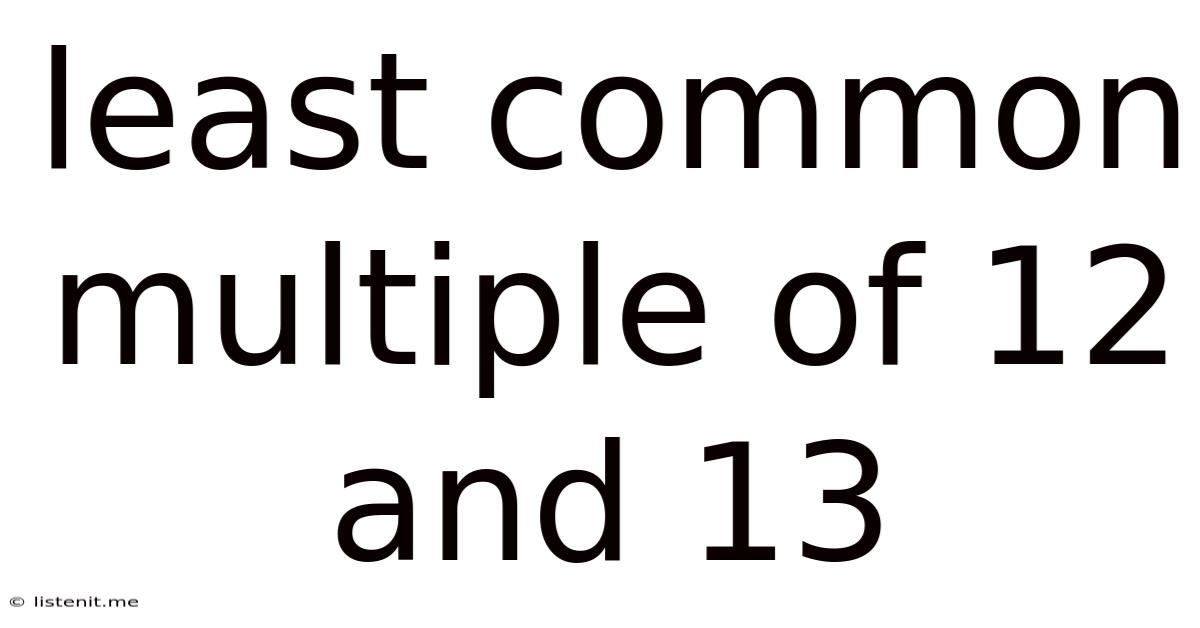Least Common Multiple Of 12 And 13
listenit
May 13, 2025 · 4 min read

Table of Contents
Finding the Least Common Multiple (LCM) of 12 and 13: A Deep Dive
The least common multiple (LCM) is a fundamental concept in number theory with wide-ranging applications in mathematics, computer science, and even music theory. This article will explore the LCM of 12 and 13, demonstrating various methods to calculate it and providing a deeper understanding of the underlying mathematical principles. We'll also touch upon the significance of LCM in real-world scenarios.
Understanding Least Common Multiple (LCM)
Before diving into the specifics of finding the LCM of 12 and 13, let's solidify our understanding of the concept. The LCM of two or more integers is the smallest positive integer that is divisible by all the integers without leaving a remainder. Think of it as the smallest number that contains all the given numbers as factors.
For example, the LCM of 2 and 3 is 6 because 6 is the smallest positive integer divisible by both 2 and 3.
Methods for Finding the LCM of 12 and 13
There are several approaches to determine the LCM of 12 and 13. Let's examine the most common methods:
1. Listing Multiples Method
This is a straightforward, albeit time-consuming method, especially for larger numbers. We list the multiples of each number until we find the smallest multiple common to both.
- Multiples of 12: 12, 24, 36, 48, 60, 72, 84, 96, 108, 120, 132, 144, 156...
- Multiples of 13: 13, 26, 39, 52, 65, 78, 91, 104, 117, 130, 143, 156...
Notice that 156 is the smallest number appearing in both lists. Therefore, the LCM of 12 and 13 is 156. This method becomes impractical for larger numbers or when dealing with multiple numbers simultaneously.
2. Prime Factorization Method
This method is more efficient and works well for larger numbers. It involves finding the prime factorization of each number and then constructing the LCM using the highest powers of all prime factors present.
- Prime factorization of 12: 2² × 3
- Prime factorization of 13: 13 (13 is a prime number)
To find the LCM, we take the highest power of each prime factor present in the factorizations:
LCM(12, 13) = 2² × 3 × 13 = 4 × 3 × 13 = 12 × 13 = 156
This method is more systematic and less prone to error, especially when dealing with larger numbers.
3. Greatest Common Divisor (GCD) Method
The LCM and GCD (Greatest Common Divisor) of two numbers are closely related. The product of the LCM and GCD of two numbers is equal to the product of the two numbers. This relationship can be expressed as:
LCM(a, b) × GCD(a, b) = a × b
First, we need to find the GCD of 12 and 13 using the Euclidean algorithm or prime factorization.
- Prime factorization of 12: 2² × 3
- Prime factorization of 13: 13
Since 12 and 13 share no common prime factors, their GCD is 1.
Now, we can use the formula:
LCM(12, 13) = (12 × 13) / GCD(12, 13) = (156) / 1 = 156
This method is particularly useful when dealing with larger numbers where finding the prime factorization might be computationally expensive.
The Significance of LCM
The LCM has several practical applications across various fields:
1. Scheduling and Time Management
Imagine you have two machines that operate on cycles. One completes a cycle every 12 minutes, and the other every 13 minutes. To find the time when both machines will complete a cycle simultaneously, we need to find the LCM of 12 and 13, which is 156 minutes. This concept extends to scheduling tasks, appointments, and coordinating events.
2. Fraction Operations
When adding or subtracting fractions with different denominators, finding the LCM of the denominators is crucial to obtain a common denominator. This simplifies the process and leads to a more manageable calculation.
3. Music Theory
In music, the LCM is used to determine the least common period of rhythmic patterns or melodies. It helps in understanding the relationships between different rhythms and their simultaneous occurrence.
4. Computer Science
The LCM plays a role in algorithms related to synchronization, scheduling processes, and managing resources in computer systems. Understanding the concept ensures efficient resource allocation and prevents conflicts.
5. Modular Arithmetic
LCM finds applications in modular arithmetic, a branch of number theory concerned with arithmetic operations within a given modulus.
LCM of 12 and 13: A Summary
The least common multiple of 12 and 13 is 156. We explored three methods to arrive at this answer: listing multiples, prime factorization, and the GCD method. Each method offers a different perspective and approach, with the prime factorization and GCD methods being particularly efficient for larger numbers. The concept of LCM extends beyond theoretical mathematics; it's a fundamental tool with significant applications across various domains. Understanding and applying this concept efficiently can greatly simplify various problems and optimize processes. From scheduling tasks to simplifying fractions, the LCM consistently proves its utility in diverse real-world applications. Mastering the concept of LCM significantly enhances problem-solving skills and provides a deeper appreciation for the interconnectedness of mathematical principles.
Latest Posts
Latest Posts
-
How Are Lactic Acid Fermentation And Alcoholic Fermentation Different
May 13, 2025
-
Is A Solution A Homogeneous Or Heterogeneous Mixture
May 13, 2025
-
Isotopes Of The Same Element Have The Same Number Of
May 13, 2025
-
What Is The Area Of Rhombus Abcd
May 13, 2025
-
How Many Electrons Does S 2 Have
May 13, 2025
Related Post
Thank you for visiting our website which covers about Least Common Multiple Of 12 And 13 . We hope the information provided has been useful to you. Feel free to contact us if you have any questions or need further assistance. See you next time and don't miss to bookmark.